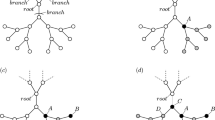Abstract
Models and algorithms for weakening and destruction of malicious complex internet networks are widely studied in AI in recent years. These algorithms must detect critical links and nodes in a dynamic network whose removals maximally destroy or spoil the network’s functions. In this paper we propose a new approach for solution of this problem. Instead of removal of corresponding key segments of networks we initiate intentional misrepresentation in important sites leading to wrong network evolution that in fact is equivalent to weakening/destruction of the network. Specifically, we cause and study artificial decentralization and artificial fragmentation in the network. For simulation of these phenomena, we apply and develop a network model based on nonuniform random recursive trees, so called one-max constant-probability network.
Access this chapter
Tax calculation will be finalised at checkout
Purchases are for personal use only
Similar content being viewed by others
References
Arulselvan, A., Commander, C.W., Elefteriadou, L., Pardalos, P.M.: Detecting critical nodes in sparse graphs. Comput. Oper. Res. 36(7), 2193–2200 (2009)
Barabási, A.-L., Albert, R.: Emergence of scaling in random networks. Science 286(5439), 509–512 (1999)
Dinh, T.N., Xuan, Y., Thai, M.T., Park, E.K., Znati, T.: On approximation of new optimization methods for assessing network vulnerability. In: INFOCOM 2010, Proceedings of the IEEE Browse Conference Publications, pp. 1–9, San Diego, CA, March 2010
Dinh, T.N., Xuan, Y., Thai, M.T., Pardalos, P.M., Znati, T.: On new approaches of assessing network vulnerability: hardness and approximation. IEEE/ACM Trans. Netw. 20(2), 609–619 (2012)
Gustedt, J.: Generalized attachment models for the genesis of graphs with high clustering coefficient. In: Fortunato, S., Mangioni, G., Menezes, R., Nicosia, V. (eds.) Complex Networks. Studies in Computational Intelligence, vol. 207, pp. 99–113. Springer, Berlin (2009). doi:10.1007/978-3-642-01206-8_9
Katona, Z.: Levels of a scale-free tree. Random Struct. Algorithms 29(2), 194–207 (2012)
Korenblit, M., Talis, V., Levin, I.: One-max constant-probability models for complex networks. In: Contucci, P., Menezes, R., Omicini, A., Poncela-Casasnovas, J. (eds.) Complex Networks V. SCI, vol. 549, pp. 181–188. Springer, Cham (2014). doi:10.1007/978-3-319-05401-8_17
Li, M., Gao, L., Zhou, W.: S-Kcore: a social-aware Kcore decomposition algorithm in pocket switched networks. In: IEEE/IFIP 2010: Proceedings of the IEEE/IFIP 8th International Conference Embedded and Ubiquitous Computing 2010, IEEE, Piscataway, N.J., pp. 737–742
Molisz, W., Rar, J.: End-to-end service survivability under attacks on networks. J. Telecommun. Inform. Technol. 3, 19–26 (2006)
Peixoto, T.P., Bornholdt, S.: Evolution of robust network topologies: emergence of central backbones. Phys. Rev. Lett. 109, 118703 (2012)
Shen, Y., Dinh, T.N., Thai, M.T.: Adaptive algorithms for detecting critical links and nodes in dynamic networks. In: 2012 IEEE Military Communications Conference Browse Conference Publications, MILCOM 2012, pp. 1–6, Orlando, FL, 29 October–1 November 2012
Thompson, K.R.: Phoenix Algorithm: A Behavior-Predictive Algorithm. http://educology.indiana.edu/Thompson/Phoenix%20Algorithm.pdf
Acknowledgment
The author warmly thanks Eugene Levner for his helpful advises and interesting comments.
Author information
Authors and Affiliations
Corresponding author
Editor information
Editors and Affiliations
Rights and permissions
Copyright information
© 2017 Springer International Publishing AG
About this paper
Cite this paper
Korenblit, M. (2017). A New Approach to Weakening and Destruction of Malicious Internet Networks. In: Pichardo-Lagunas, O., Miranda-Jiménez, S. (eds) Advances in Soft Computing. MICAI 2016. Lecture Notes in Computer Science(), vol 10062. Springer, Cham. https://doi.org/10.1007/978-3-319-62428-0_37
Download citation
DOI: https://doi.org/10.1007/978-3-319-62428-0_37
Published:
Publisher Name: Springer, Cham
Print ISBN: 978-3-319-62427-3
Online ISBN: 978-3-319-62428-0
eBook Packages: Computer ScienceComputer Science (R0)




